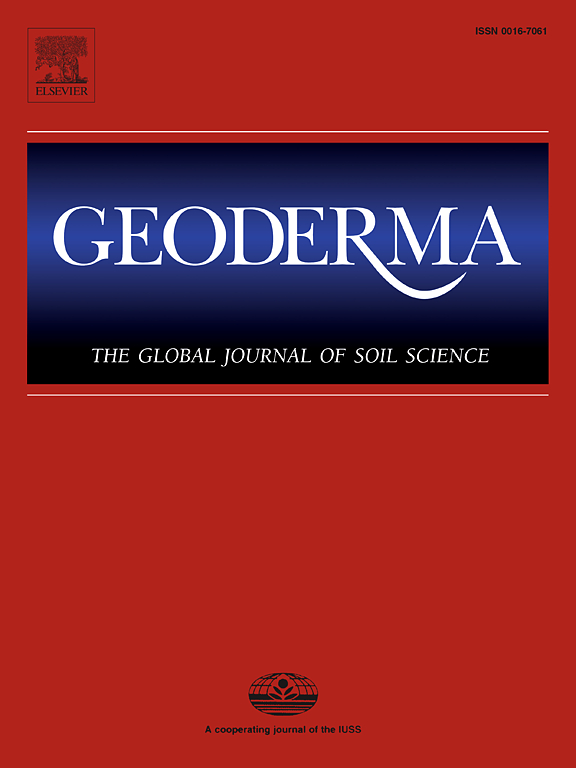A novel ecological risk assessment method of potentially toxic elements based on soil nematode communities
IF 6.6
1区 农林科学
Q1 SOIL SCIENCE
引用次数: 0
Abstract
Potentially toxic elements (PTEs) in soil near coal mines threaten soil biota, ecosystem stability, and human health. Soil nematodes, which quickly respond to environmental changes, are reliable biological indicators of PTEs contamination. However, research on establishing a systematic ecological risk assessment model for PTEs contamination using general community indices and nematode-based indices (NBIs) are limited. To address the research gap, we selected 7 cities in Shanxi Province, China, where coal mining is actively conducted. Bayesian kernel machine regression (BKMR) was used to analyze dose–response relationships of PTEs, general community indices, and NBIs. Additionally, based on the general community indices and NBIs, the study developed ecological risk assessment models of PTEs using machine learning techniques. The results showed moderate pollution with significant spatial and seasonal variations, and PTEs such as Pb, Hg, Mn, and Zn concentrations significantly exceeded (0.2 to 6.35 times) than background values. Structure index (SI), nematode channel ratio (NCR), and maturity index (MI) showed negative linear dose–response relationships with PTEs concentration. The ridge regression (Ridge) model performed the best for the nemerow synthetic pollution index (NSPI) and potential ecological risk index (RI) of comprehensive PTEs, while the random forest (RF) model performed the best for the pollution load index (PLI). NCR, MI, and Shannon-Weaver diversity index (H) were the most important factors in determining NSPI (NCR = 21.08 %, MI = 20.78 %, and H = 18.48 %) and RI (NCR = 20.90 %, MI = 20.90 %, and H = 19.50 %). The results highlight that PTEs contamination near coal mine areas was severe, leading to significant disturbances in nematode community structure. Applying general community indices and NBIs, Ridge and RF models can effectively predict the ecological risks of PTEs.

基于土壤线虫群落的潜在有毒元素生态风险评估新方法
煤矿附近土壤中的潜在有毒元素(pte)对土壤生物区系、生态系统稳定性和人类健康构成威胁。土壤线虫对环境变化反应迅速,是pte污染的可靠生物指标。然而,利用一般群落指数和基于线虫的指数(NBIs)建立pte污染系统生态风险评价模型的研究有限。为了弥补研究空白,我们选择了中国山西省7个煤炭开采较为活跃的城市。采用贝叶斯核机回归(BKMR)分析pte、一般群落指数和nbi的剂量-反应关系。此外,基于一般群落指数和nbi,利用机器学习技术建立了pte生态风险评估模型。结果表明:污染程度为中度,存在显著的空间和季节变化,Pb、Hg、Mn、Zn等pte浓度显著高于背景值(0.2 ~ 6.35倍);结构指数(SI)、线虫通道比(NCR)和成熟度指数(MI)与PTEs浓度呈负线性剂量效应关系。山脊回归(ridge)模型对综合污染环境的内梅罗综合污染指数(NSPI)和潜在生态风险指数(RI)表现最好,随机森林(RF)模型对污染负荷指数(PLI)表现最好。NCR、MI和Shannon-Weaver多样性指数(H)是决定NSPI (NCR = 21.08%, MI = 20.78%, H = 18.48%)和RI (NCR = 20.90%, MI = 20.90%, H = 19.50%)的最重要因素。结果表明,煤矿附近pte污染严重,导致线虫群落结构受到明显干扰。应用一般群落指数和nbi, Ridge和RF模型可以有效预测pte的生态风险。
本文章由计算机程序翻译,如有差异,请以英文原文为准。
求助全文
约1分钟内获得全文
求助全文
来源期刊

Geoderma
农林科学-土壤科学
CiteScore
11.80
自引率
6.60%
发文量
597
审稿时长
58 days
期刊介绍:
Geoderma - the global journal of soil science - welcomes authors, readers and soil research from all parts of the world, encourages worldwide soil studies, and embraces all aspects of soil science and its associated pedagogy. The journal particularly welcomes interdisciplinary work focusing on dynamic soil processes and functions across space and time.
 求助内容:
求助内容: 应助结果提醒方式:
应助结果提醒方式:


